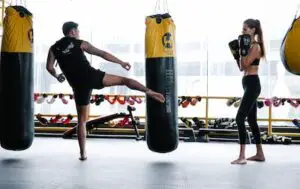Karate, a traditional Japanese martial art, has gained global popularity for its effective self-defense techniques, discipline, and physical fitness benefits. As the art of empty-hand combat, karate encompasses various styles and forms, each with its unique characteristics. In this article, we will delve into the different types of karate, shedding light on their origins, techniques, and philosophies. Whether you’re a martial arts enthusiast or someone considering starting karate training, this guide will provide you with valuable insights into the fascinating world of karate.
What is the history of karate?
Karate traces its origins back to the Ryukyu Kingdom (present-day Okinawa, Japan) during the 17th century. It was influenced by Chinese martial arts, which were introduced to the Ryukyu Islands through trade and cultural exchanges. Initially known as “ti” or “te,” meaning “hand” in the local dialect, karate was primarily practiced in secret due to the prohibition of weapons by the ruling authorities. Over time, karate evolved and incorporated indigenous Okinawan fighting techniques, leading to the development of various styles.
What are the main types of karate?
- Shotokan Karate: Founded by Gichin Funakoshi, Shotokan is one of the most popular styles of karate worldwide. It emphasizes strong stances, powerful strikes, and dynamic movements.
- Goju-Ryu Karate: Developed by Chojun Miyagi, Goju-Ryu focuses on a combination of hard and soft techniques, incorporating circular movements and close-quarter combat strategies.
- Wado-Ryu Karate: Wado-Ryu, founded by Hironori Ohtsuka, blends karate techniques with principles of Jujutsu. It emphasizes fluid movements, evasion, and redirecting an opponent’s energy.
- Shito-Ryu Karate: Kenwa Mabuni established Shito-Ryu, which combines elements of Shuri-te and Naha-te, two influential Okinawan styles. Shito-Ryu places equal emphasis on power, speed, and gracefulness.
- Kyokushin Karate: Masutatsu Oyama developed Kyokushin Karate, renowned for its rigorous training methods and full-contact sparring. It emphasizes strong punches, kicks, and conditioning.
- Shotokai Karate: Shotokai is an offshoot of Shotokan Karate, founded by Shigeru Egami. It focuses on natural body movements, breathing, and internal energy development.
What are the distinctive characteristics of each karate style?
a. Shotokan Karate: Known for its deep stances, strong linear punches, and kicks, Shotokan emphasizes long-range techniques and powerful strikes.
b. Goju-Ryu Karate: Goju-Ryu combines hard strikes with circular movements, focusing on close-quarter combat and incorporating various breathing techniques.
c. Wado-Ryu Karate: Wado-Ryu incorporates fluid and evasive movements, aiming to redirect an opponent’s energy and use their force against them.
d. Shito-Ryu Karate: Shito-Ryu combines power, speed, and agility with a focus on well-rounded techniques, including strong punches, kicks, and grappling.
e. Kyokushin Karate: Kyokushin is characterized by its intense physical conditioning, full-contact sparring, and emphasis on strong, low kicks and powerful strikes.
f. Shotokai Karate: Shotokai emphasizes natural body movements, relaxation, and internal energy cultivation, focusing on efficient techniques and fluidity.
Sub-Question 4: What are the training methods in each karate style? (300 words) Each karate style employs specific training methods to develop physical strength, discipline, and technique mastery. While these methods may vary, common training elements include:
a. Basics and Kihon: All styles emphasize practicing fundamental techniques such as punches, kicks, blocks, and stances to build a solid foundation.
b. Kata: Kata refers to pre-arranged sequences of movements simulating combat scenarios. Different styles have their unique kata, which serve as repositories of techniques and principles.
c. Kumite: Kumite involves sparring or controlled fighting with an opponent. The intensity and rules vary between styles, with some emphasizing full-contact while others prioritize controlled strikes.
d. Conditioning: Many karate styles incorporate physical conditioning exercises like strength training, endurance building, and flexibility drills to develop overall fitness.
How does the philosophy differ across karate styles?
While karate styles share a common goal of self-improvement, discipline, and respect, their philosophical approaches may differ. Some styles prioritize traditional values and spiritual development, while others focus on practicality and effective self-defense techniques. The philosophical aspects often manifest through the teaching methods, training etiquette, and emphasis on mental discipline.
Which karate style should you choose?
Choosing the right karate style depends on your personal goals, preferences, and the availability of training facilities in your area. Consider factors such as the style’s philosophy, training methods, and compatibility with your physical abilities. It is also essential to visit local dojos, observe classes, and consult with experienced instructors to gain insights into each style’s teaching approach. Ultimately, the most important aspect is finding a qualified instructor who can guide you on your karate journey and help you achieve your goals.
Conclusion
Karate is a martial art rich in history, technique, and philosophy. From Shotokan’s powerful strikes to Kyokushin’s full-contact sparring, each karate style offers unique experiences and benefits. By understanding the origins, characteristics, and training methods of different karate styles, you can make an informed decision about which path to embark on. Whichever style you choose, karate promises physical fitness, self-defense skills, mental discipline, and personal growth. So, step onto the dojo floor, embrace the art of karate, and unlock the numerous rewards it offers.





